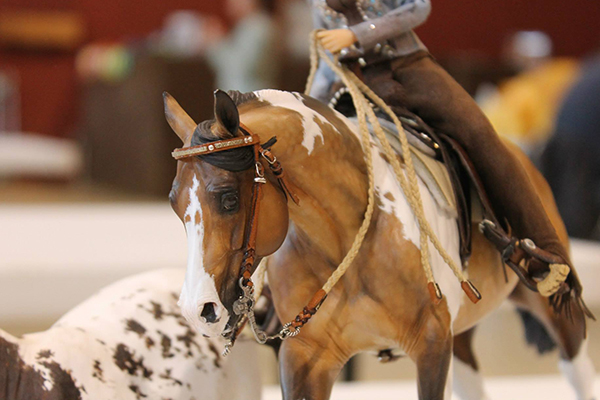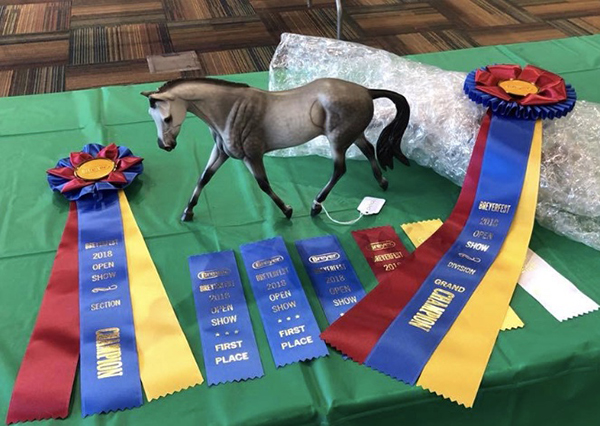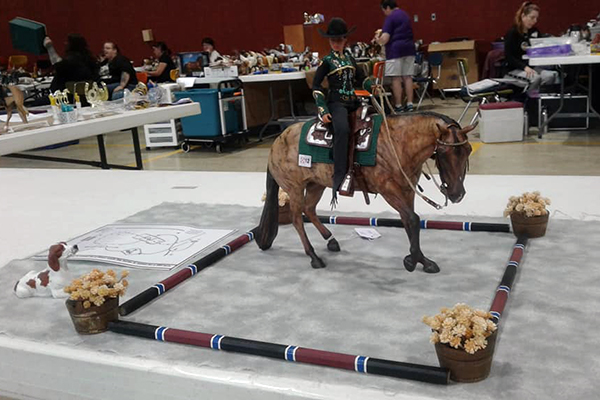
Meet fellow horse lovers while displaying your beloved model horses when you enter the world of model horse showing. Perfect for collectors and enthusiasts of all ages, these collectible models help to ignite the imagination while instilling a lifelong love of horses. Combining camaraderie with equine education, it’s easy to see why showing model horses has become increasingly popular. In fact, many customers at The Cheshire Horse are involved in this exciting hobby.
Jennifer Bolton-Johnson, a frequent shopper in our Swanzey, NH, store has been model horse showing for over 20 years. She originally showed in her 4-H groups’s annual horse show, but after taking a short hiatus during college, she began to show at North American Model Horse Show Association (NAMSHA) rated shows. At these shows, model horses from Breyer Animal Creations, CollectA, Peter Stone, Copperfox, Schliech, and other model companies compete against each other in a variety of classes.
When it comes to showing model horses, there are two main divisions of classes: halter classes and performance classes. Just like with their living counterparts, halter classes are judged on breed characteristics while performance classes are judged with tack according to their division specifications. There is also a collectibility division, which is becoming increasingly popular throughout the region.
Halter Division
In the halter division, model horses are judged according to their conformation, as well as anatomy and how their compare to the breed that you have assigned to them. Many horses show under the breed which the manufacturer has created them to represent, while in other circumstances, exhibitors find that the mold and paint job more accurately represent a different breed.

“People get really creative in their breed assignments,” explains Jennifer. “Written and photographic documentation is used to show how the model looks like the real horse breed it’s representing.” Other aspects, like obscure color patterns and genetic mutations are researched thoroughly to ensure that the entry is factual, examples of this may include sabino coloring in Arabians or splash color genetics in various lines of Warmbloods.
Breed suitability and correct documentation is a large part of competing in breed classes, but is not the only thing that the judges take into consideration.The anatomy and conformation of the horse should be correct and realistic, while the condition of the model is highly important. Just like as with their larger, breathing counterparts, a model horse that is missing an ear will not be winning any halter classes!
Most commonly, horses of all sizes compete against each other, but occasionally traditional sized (1:9 scale) and classic sized (1:12 scale) have a separate division from the smaller miniature molds like Stablemates (1:32 scale), Schliech horses, CollectA, and the even smaller Mini Whinnies (1:64 scale). This is due to the fact that additional detail and shading can be achieved on the slightly larger models.
Performance Classes
Katherine Dwyer, another model horse show exhibitor who frequents The Cheshire Horse, currently competes primarily in the performance divisions. Her attention to detail and high quality models and tack have worked together to win over 160 Performance Division Championships in a dozen states, including multiple NAMHSA Regional and National Championships and Reserves and, most recently, the Original Finish Overall Performance Championship at last year’s Breyerfest.

In these classes, model horses are tacked up and ridden by scale riders; they are also surrounded by props and accessories to help set the scene. A live show performance entry is like a diorama depicting a split second of a real horse performance discipline: cross country, hunter/jumper, dressage, reining, gymkhana games, saddleseat, marathon driving – you name it, model horses can do it too.
“There are size limitations, and the entry has to conform to that specific discipline’s rules,” says Katherine. “The model must have tack that is appropriate and is fitted well. It must be ‘doing’ the event depicted, and should include a small written explanation card for the judge. Neatness and accuracy count! Rider dolls are usually not required, but if an exhibitor uses them, they better have excellent equitation to be competitive!”
Just like the halter divisions, well researched entries are often more successful. In order for a performance setup to succeed, the tack needs to fit correctly and it needs to adhere to the rules of the class that they are competing in. For Katherine, this is part of the challenge of competing in model horse performance classes, “I have spent tons of time reading the rules for equestrian disciplines of all types that I was unfamiliar with in order to produce successful entries.”
Collectibility Classes
Collectibility classes are becoming increasingly popular with collectors. These classes assess the collectible value of the models and rank them based on desirability. Vintage models, limited edition models, and Breyerfest special edition models often fare well in these classes. Models with paint variations are often seen in these classes as well.
In addition to being an active model horse show competitor, Jennifer Bolton-Johnson is also an experienced judge in the collectibility classes. “For collectibility, we really look at a few things; condition, rarity, and desirability are the biggest points,” she explains. “Unlike in the halter division, anatomy, color (unless it is rare or different), and conformation do not really matter in collectibility.”
Terms of the Trade
Just like showing horses, there are many terms that are used specifically for showing model horses. Model horses that are direct from the factory are referred to as Original Finish or OF models. Talented artists take models and paint and/or modify them to compete in the Custom or CM division.

In addition to the mass produced plastic molds, there is another, albeit more pricey, option. Artist Resins or ARs are professionally produced models that are made of resin; they are then painted to the artist’s or the owner’s specifications. Because these models are often more detailed than the mass-produced models, CM and AR horses compete separately to keep a level playing field.
Fun For All Ages
This collectible hobby offers adults and children an opportunity to compete equally. Some showers have been competing their entire lives, while others enter the hobby after their children begin collecting.
In addition to the competitive open divisions, many model horse shows are beginning to hold novice divisions. These shows are a tremendous way to get a taste of the world of model horse showing without becoming overwhelmed. Entrants of all ages are welcomed, and the classes run more slowly to allow the new exhibitors time to keep up. The judge will also take the time to explain their placings as well as tell exhibitors how they can improve in the future.
The advent of the internet and social media has made it even easier to enter the world of live model horse showing. In New England and New York, the Region 10 Chapter of the NAMHSA organizes a website to keep their active base of hobbyists connected. All upcoming shows in the region are listed, along with their show packet which includes everything that you need to know about the show.
“Shows are usually very welcoming to newbies, both juniors and adult novices, who might just want to visit first and see what it is about,” says Katherine as she offers words of advice. “Stop by a show to see what it is all about or jump right in and buy models to compete. Start small, bring just a handful of models. Don’t overwhelm yourself, and don’t forget to have fun!” As newer competitors get used to the pace and format, they can add models to their entry lists and compete in more than one division.
More Than A Horse Show
In addition to being a way to enjoy collecting Breyers and other model horses, showing allows like-minded people to connect and build friendships. “I love it because right now I can’t have a real horse, and this lets me get creative and enjoy horses without actually being able to own a living horse,” says Jennifer. “I have made so many friends in the hobby and go to Breyerfest every year at the Kentucky Horse Park where I see friends that I have made all from all over the country.”
It seems that horses of all shapes and sizes have the innate ability to bring people together and build a sense of camaraderie. Consider dipping your toe into this exciting hobby that combines the love of horses with education, research, and creativity.
If you are looking to build your collection or bolster your show string, The Cheshire Horse carries a wide variety of Breyer Horses. In fact, as a Breyer flagship store, we have access to special edition models that are not available in all locations. In addition to our extensive online selection, we have additional models in our brick and mortar stores, so be sure to stop by and see what we have in stock.

Nice article, Cheshire Horse!
Long-time collector and shower here…. since 1975.
There are online photo shows as well for collectors who want to show, but can’t travel to a live show. MEPSA is just one of them… http://mepsa1.tripod.com/
great artical since there is not any live shows recently i have started to take pictures of my models and show them in MEPSA novice classes, i am glad that they have this division, as i am just starting out, and i am trying to find out more information on how to do on line photo shows, i have a digital camera with an SD card feel free to shoot me an email if you want
i live here in concord nh
thanks